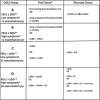Paradigms in chronic obstructive pulmonary disease: phenotypes, immunobiology, and therapy with a focus on vascular disease
- PMID: 28258130
- PMCID: PMC5889938
- DOI: 10.1136/jim-2016-000358
Paradigms in chronic obstructive pulmonary disease: phenotypes, immunobiology, and therapy with a focus on vascular disease
Abstract
Chronic obstructive pulmonary disease (COPD) is a complex and heterogeneous syndrome that represents a major global health burden. COPD phenotypes have recently emerged based on large cohort studies addressing the need to better characterize the syndrome. Though comprehensive phenotyping is still at an early stage, factors such as ethnicity and radiographic, serum, and exhaled breath biomarkers have shown promise. COPD is also an immunological disease where innate and adaptive immune responses to the environment and tobacco smoke are altered. The frequent overlap between COPD and other systemic diseases, such as cardiovascular disease, has influenced COPD therapy, and treatments for both conditions may lead to improved patient outcomes. Here, we discuss current paradigms that center on improving the definition of COPD, understanding the immunological overlap between COPD and vascular inflammation, and the treatment of COPD-with a focus on comorbid cardiovascular disease.
Keywords: Comorbidity; Phenotype; Pulmonary Disease, Chronic Obstructive.
Copyright © 2017 American Federation for Medical Research.
Conflict of interest statement
Competing interests: None declared.
Figures


References
-
- 2017 GIfCOLDG. The Global Strategy for the Diagnosis, Management, and Prevention of COPD. 2017 http://goldcopd.org/
-
- Rennard SI, Locantore N, Delafont B, et al. Identification of five chronic obstructive pulmonary disease subgroups with different prognoses in the ECLIPSE cohort using cluster analysis. Annals of the American Thoracic Society. 2015;12:303–12. - PubMed
-
- Rennard SI. The Promise of Observational Studies (ECLIPSE, SPIROMICS, and COPDGene) in Achieving the Goal of Personalized Treatment of Chronic Obstructive Pulmonary Disease. Seminars in respiratory and critical care medicine. 2015;36:478–90. - PubMed
-
- Yoneyama K, Donekal S, Venkatesh BA, et al. Natural History of Myocardial Function in an Adult Human Population: Serial Longitudinal Observations From MESA. JACC Cardiovascular imaging. 2016;9:1164–73. - PubMed
Publication types
MeSH terms
Grants and funding
LinkOut - more resources
Full Text Sources
Other Literature Sources
Medical

